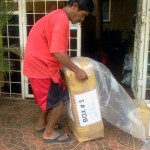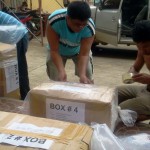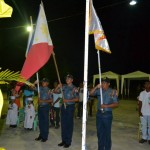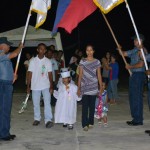
Philippine Defense Today (Adroth.ph)
In Defense of the Republic of the PhilippinesAnyone can stand up to China’s bullying
Monday , 5, August 2013 adroth92 External defense Leave a commentAt the best of times, hostilities between nations are the exclusive domain of the ambassadors. At worst, they are the province of the generals tasked to apply martial solutions to the problem. Tensions between the Philippines and the People’s Republic of China are no different in that they leave the man-on-the-street with no scope for involvement beyond street and online protests — which may very well fall on deaf Sino ears.
However, thanks to the Chinese Foreign Ministry, all that changed on the 25th of June 2012. Ten days earlier, the Municipality of Kalayaan opened the Pag-asa Elementary School which sought to end the 34-year absence of educational opportunities on Pag-asa Island. To this end, island residents converted an unused multi-purpose building into a one-classroom facility, and sought the services of a teacher who agreed to be relocated to Pag-asa. The municipality inaugurated the school on the 15th of June.
 |
The Chinese foreign ministry, always keen to respond to any perceived challenge to PRC claims or international positions, condemned the school’s creation with the following press release.
 |
Long-time China-watchers recognized the press release as a routine activity. It was reminiscent of the tit-for-tat exchange that regularly took place between the foreign affairs ministries of Taiwan and mainland China (Note: The author lived in Taiwan for 3.5 years and saw these exchanges first-hand). However in this instance, it inadvertently brought the issue down to the level of the everyday Filipino. With that press statement, China associated its sovereignty with the fate of the school. This meant that for as long as the school remained open, it was an affront to Chinese claims over the territory. Consequently, anyone who helped to ensure school’s success, was DIRECTLY challenging Chinese claims within the Philippine EEZ. China had given the Filipino people a tangible, permanent, means of protesting its machinations in the Western Philippine Sea.
The opportunity this unique turn of events created was not lost upon members of the Timawa Donation Group (TDG) — a sub-set of an online national defense-oriented community known as Timawa.net (translation: Free man) that had long been involved in efforts to provide assistance to individual AFP units as well as to support AFP community outreach programs. The TDG promptly organized an exploratory project in June 2012 to develop procedures for the collection of donations and their transport to the Pag-asa Elementary School. As a precaution in the pilot project, participation was by invitation only. Volunteers from the United States, Singapore, and various cities within the Philippines took part.
The group wrapped up the project in November 2012 with the successful turnover of goods to the liaison office of the Western Command of the Armed Forces of the Philippines in Camp Aguinaldo, Quezon City. The group had corresponded with the commanding officer of the command at the time, who then endorsed the group to his Public Information Officer who offered to facilitate transport of the items. However, scheduling difficulties meant that the items did not actually reach Pag-asa island till early 2013. Despite the delay, donation items successfully reached the school. Lessons were learned, procedures modified and the pilot was declared a success. Project proponents created the following video to celebrate the completion of the pilot project.
Encouraged by the results of the first run, the group launched the 2013 effort on June 14, with a synchronized delivery date of October 20. With the first live project donation items were sent directly to the Kalayaan Extension Office in Puerto Princessa, Palawan.
Now operating under the hashtag “#pagasaKIG”, participation in the project was opened to all interested parties. Invitations to participate were issued on the main Timawa.net forum (see A year of defiance [#pagasaKIG]), as well as on the Kalayaan Island Group development forum group on Facebook.
 |
Although the project deadline was set for October, the group decided to take advantage of the availability of a Philippine Navy vessel for transporting goods in August. The Makati node for the project sent an early batch of items consisting of five boxes containing various books, school and personal hygiene supplies was sent to the Kalayaan Extension Office in Puerto Princessa on July 31st.
 |
 |
 |
 |
The boxes arrived in Puerto Princessa the following day and are due for delivery to Pag-asa island in early August. The photographs below show personnel at the Kalayaan extension office sealing the boxes in plastic to protect them for the journey to Pag-asa.
 |
 |
 |
All other nodes are still scheduled to send their items in on October the 20th — including the Makati node which will be sending a second package on that date.
About the school
When the Pag-asa Elementary School opened, the Department of Education (DepEd) had not yet assumed administration of the school. At that point the municipality had not yet complied with all the requirements for the establishment of the school. Among the requirements was the formal turn over of land for the school; a task complicated by the absence of land titles on the island. The DepEd also required financial commitment from municipality to fund the school for the next five years. While these requirements were being worked out, the municipal government and the DepEd entered into a Memorandum of Agreement to allow the school to operate.
Eight kindergarten students and a lone teacher populated the school in its inaugural school year. Although there were a total of 24 children on the island five were not yet of school age, and the rest had enrolled in Palawan by the time the school opened. By the end of the school year, four of the children graduated, and the teaching staff grew to two educators.
 |
 |
 |
School Year 2013-2014 saw a number of noteworthy improvements:
- The municipality had already complied with the one-hectare land allocation requirement imposed by the DepEd
- A second building, funded by the Ayala Foundation, was under construction. A third building funded by the Provincial government was being processed
- Enrollment jumped to 23 students ranging from kindergarten to Grade 6
The photographs below show the enlarged student body celebrating nutrition month along with the island’s military residents.
 |
 |
 |
The Pag-asa Elementary School, a symbol of a republic’s defiance against foreign encroachment, was gaining steam. Maintenance of that momentum, however, is contingent upon continued support by the remainder of the republic. If this school fails . . . China wins.
 |